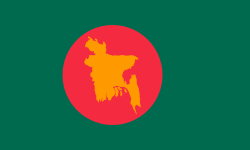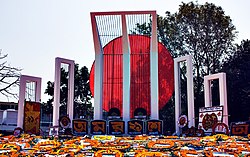Cable 1971
Cable 1971, otherwise known as Priority Signal or File 1971 was a high profile and secret military signal communicated in December 1952 between the two main inter-services branches of Pakistan–the Pakistan Army and the Pakistan Navy. [25] : 219 It is notable for the fact that it essentially predicted the separation of Pakistan and Bangladesh and by coincidence its title contained the year in which the separation actually happened, almost 20 years later.
The cable discussed the implication of One Unit and one culture policy, religious fanaticism, and the economic parity between the West and East Pakistan that will ultimately result in the division of Pakistan into two different groups. [25] : 219–220
The cable's message read as:
- The creation of Committee of Ulema to veto the decisions taken in the House of People on religious matters, gives excess of powers to Ulema over the rights of elected representatives of the people. This gives an impression of Pakistan as being a theocratic state. [25] : 219–220
- To recommend that the head of the state should be a Muslim will unnecessarily create suspicions in minds of the minorities in Pakistan. The choice to select the head of the state should be left entirely to the people, to select without prejudice to caste, colour and creed. [25] : 219–220
- It is maintained by same officers that a single House elected on population basis should have been envisaged, and we should cease to think in terms of Bengalis, Pathans, Balochis, Sindhis, Punjabis etc. The parity between West & East Pakistan will ultimately result in the division of Pakistan into two different groups, therefore, it is the very negation of one people, one country and one culture. [25] : 219–220
The cable is notable for its highlighted title and many historians found strange that the cable was coincidentally numbered: Cable/File 1971. [25] : 210
Bengali language as national identity
Language played a key role in the independence movement of Bangladesh and became a key feature in nation-building after the Liberation War against Pakistan. Since the foundation and independence of Pakistan in 1947, language was a key dividing issue in the newly established state. The new Pakistani elite faced a difficult task of uniting all its citizens into a united Pakistani nation, and one immediate question that arose with the new state was about the language that would be used to conduct Pakistan's state business. The Pakistan Educational Conference of November 1947 proposed Urdu as the national language even though it was spoken by only 3% of Pakistanis, compared to 56% who spoke Bengali. The first population census revealed that Pakistan had 78 million inhabitants, of whom 44 million (55%) lived in East Pakistan. However, the country's rulers were concentrated in West Pakistan and used Islam to dismiss Bengali's protests as un-Islamic or anti-Islamic. Students in East Pakistan held meetings and demonstrations and formed the Language Action Committee in December 1947 when they learned about the plans to make Urdu the national language. [26]
The Bengali language movement, or Bhasha Andolon, was started by students at schools, colleges and universities. The success of this movement forced Pakistan to change its policies and fueled the emergence of Bengali ethno-nationalism, which led to the creation of Bangladesh as an independent state and the breakup of Pakistan in 1971. When the movement began to challenge West Pakistani domination in East Pakistan, the citizens and the press in West Pakistan thought that it was orchestrated by Hindus, communists and anti-state elements trying to destabilize the state. [27] Thousands of young Bengali boys and girls from schools and universities in Dhaka assembled on the campus of Dhaka University marching and shouting slogans like "Bengali as a national language!" (rastrabhdsa bamla cai!). As soon as the students passed the campus gates, armed policemen baton-charged them; the students retaliated by throwing bricks before policemen fired tear gas into the crowd as a response. Many were injured while five people died; demonstrations, killings, and arrests would continue for a few more days. A memorial was then erected on the spot where the first killings had taken place. A 1984 textbook introduces the language movement with the following, "February 21 of 1952 was the first united expression of Bangladesh's collective consciousness and a first bold step toward the independence movement". The language movement became a symbol for Bengali nationalism; the claim by Bengali textbooks is that 'Bengali' became the primary marker of Bangladesh's identity. [28]
Sufia Kamal, a Bangladeshi poet, wrote the poem "Our Language: The Language of Bengal" in 1952, during the time of the language movement; the poem shows how strongly language played a role in the national identity of the new state.
For our language many have died,
drawn from the arms of our mother
but down the road, smeared with their blood
I hope freedom will come to this land:
the simple language of a simple people
Will meet the demands of this our land.
The independence of Bangladesh in December 1971 regarded the national identity as a regional one, rather than a religious one like Pakistan's foundation. The new Bengali elite envisioned the society that was taking place in the delta as distinctly Bengali, where Bangladesh stood as a nation-state, a homeland to the Bengali community that had been unjustly treated in Pakistan. The main pillars of the new nation were language, a regional style, and a search for modernity.
The Bangla Academy was an institution established in the 1950s as a result of the language movement; after independence, it became a major publisher of textbooks, dictionaries, folk literature, etc. The written and the spoken language were two distinct languages, whose differences were greater than that of other languages. The language of books was distinct, and without a trace of the popular, based on Sanskrit. This fact took a turn with Tekchand Thakur's "Alarer Ghorer Dulal", which was written in the language that everyone understood. From that moment on, books began to be written in the learned and popular languages in Bangladesh. [29]




